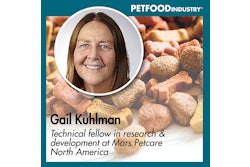
In the latest Association for the Prevention of Pet Obesity survey, veterinary professionals classified 59% of evaluated dogs as overweight or obese. While that represents a 3% increase over 2018 and 2017, the ratio of overweight to obese tilted to the heavier. In 2022, 37% of dogs were classified as overweight remained the same as in 2018. However, 22% of dogs were classified as obese, increasing from 19% in 2018.
“The increase in pet dogs (dogs owned as opposed to feral or free-roaming) classified as overweight or with obesity may be attributed to improved clinical assessments, results of pandemic-related inactivity or overfeeding, aging dog populations, variations in sample size and distribution, or other unknown influences,” APOP analysts wrote in their report. “Because the relative changes were consistent, and the distribution of pet dogs with obesity increased, we have high confidence in these results.”
The APOP survey involved both veterinarians and pet owners. In 2022, 1,152 dogs and cats were evaluated. There were 880 dogs and 272 cats. Pet owners completed 403 surveys about their dog or cat’s weight, nutrition and pet food.
“Veterinarians often remark that pet owners will be embarrassed or even angry if told their pet has obesity or needs to lose weight,” the APOP report authors wrote. “Further research is required to determine if this is true.
Until then, veterinary professionals should ask clients for permission and interest in discussing their pet’s body condition or weight loss and proceed accordingly.”
Veterinarians and pet owners differ
Differences arose among dog owners and veterinarians. In 36% of cases when dog owners rated their pet’s body condition as normal, their veterinary professional classified it as overweight to obese. Of these, 9% of owners with obese dogs classified them as having normal body condition.
Comparing the body condition of a Chihuahua to a Great Dane presents a challenge, APOP authors noted. Likewise, difference in coat types makes assessment difficult for dogs with long or thick fur.
“There are promising technological and laboratory solutions to measure body fat percentages in companion animals, and we are working to bring these developments to veterinary professionals,” they wrote.
Obesity problems for pets
“Obesity is a physiological disorder affecting numerous body systems,” APOP report authors wrote. “Pet obesity often causes secondary, preventable diseases, including diabetes, osteoarthritis, and many forms of cancer. Professionals and the pet care industry need to educate the pet-owning public better that pet obesity is a disease with significant harmful impacts on both quality of life and life expectancy.”

















